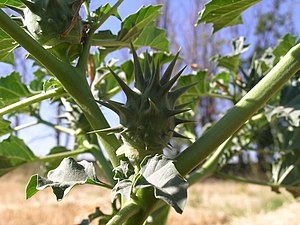Thorny thorn apple
| Thorny thorn apple | ||||||||||||
|---|---|---|---|---|---|---|---|---|---|---|---|---|

Thorny thorn apple ( Datura ferox ) |
||||||||||||
| Systematics | ||||||||||||
|
||||||||||||
| Scientific name | ||||||||||||
| Datura ferox | ||||||||||||
| L. |
The Thorny jimsonweed ( Datura ferox ) is a plant from the genus of Datura ( Datura ) in the family of the nightshade family (Solanaceae).
description
The thorny thorn apple is a 50 to 150 cm high plant (in Australia only up to 100 cm), which is mostly hairless, sometimes a sparse, pressed to protruding hairiness is reported on the not ripe leaves, on the mature plants the calyx, Leaf and flower stalks and the leaf veins scattered hairy. The stem base is partly reddish, but mostly less than the similar Datura quercifolia . The leaves are 5 to 14 cm long and 4 to 13 cm wide. They are broadly ovate to rounded triangular and roughly dentate. They are irregular, not more than a quarter of the length of the leaf blade incised, not lobed deeper than in some related species.
The calyx is 25 to 40 mm long and angular; the almost identical calyx teeth are 3 to 5 mm long. The crown is 4 to 6 cm long, funnel-shaped and white, the flowers are slightly smaller than those of Datrura stramonium .
The fruits are 5 to 8 cm long and 4 to 6 cm wide, egg-shaped capsules that stand upright and spring open regularly. They are covered with strong 10 to 30 mm long, conical spines, of which the upper ones are longer than the lower ones, the longest spines reach about half the width of the capsule. About 40 to 60 spines are formed per capsule. The numerous seeds reach 4 to 4.8 millimeters in length, they are kidney-shaped to D-shaped, they are mostly black, less often gray or brownish gray.
Occurrence
The thorny thorn apple grows almost worldwide as a weed in fields and gardens, in regions with a tropical or subtropical climate, for example in Australia, South Africa and South America (Argentina). The original home of the species is disputed. Many editors indicate East Asia, especially the south of China, as the region of origin, for example the moors in Flora Europaea. However, the species does not actually occur in China. It is also reported as a neophyte for Japan, India, Pakistan and Nepal. As one of only three species of the genus, it does not occur in Mexico, the distribution center of the genus.
When found in fields, the seeds are widely harvested and occur as a contaminant in crops such as soybeans. This leads to problems because, like all species of the genus, like all parts of the plant, they are highly poisonous due to alkaloids.
In Europe, the species is grown as an ornamental plant and is locally feral in the Mediterranean area, very rarely in North Africa. In Germany it occurs as an unstable neophyte .
ecology
The plant blooms mainly at night, it offers plenty of sugary nectar. Together with the flower tube, this is typical for flowers that are pollinated by swarmers (Sphingidae).
Taxonomy and systematics
The genus Datura includes about 10 to 13 species, depending on the view, with the main distribution in Mexico and the southern USA. According to a phylogenomic analysis, Datura ferox is a sister species of Datura quercifolia , the closest relative would be Datura stramonium . The species group forms, with four other species, the section Datura s. st. within the genus. It is supported by a morphological feature, the upright, not hanging, ripe seed pods.
In the field the species forms hybrids with the closely related common thorn apple Datura stramonium .
swell
literature
- DM Moore: Datura. In: TG Tutin, VH Heywood, NA Burges, DM Moore, DH Valentine, SM Walters, DA Webb (eds.): Flora Europaea . Volume 3: Diapensiaceae to Myoporaceae . Cambridge University Press, Cambridge 1972, ISBN 0-521-08489-X , pp. 200 (English, limited preview in Google Book Search).
- L. Haegi (1976): Taxonomic Account of Datura L. (Solanaceae) in Australia with a Note on Brugmansia Pers. Australian Journal of Botany 24: 415-435.
Individual evidence
- ↑ Datura Linnaeus. in Zhi-Yun Zhang, Anmin Lu & William G. D'Arcy (1997): Solanaceae. Flora of China, Volume 17, page 330
- ↑ Mario Luna-Cavazos & Robert Bye (2011): Phytogeographic analysis of the genus Datura (Solanaceae) in continental Mexico. Revista Mexicana de Biodiversidad 82: 977-988.
- ↑ EFSA European Food Safety Authority (editor) (2008): Tropane alkaloids (from Datura sp.) As undesirable substances in animal feed. Scientific Opinion of the Panel on Contaminants in the Food Chain. EFSA Journal 691: 1-55.
- ↑ Z. Houmani, L. Cosson & M. Houmani (1999): Datura ferox L. and D. quercifolia Kunth (Solanaceae) in Algeria. Flora Mediterranea 9: 57-60.
- ↑ Thorny thorn apple. In: FloraWeb.de.
- ↑ Carolina Torres, Mariana Mimosa, Leonardo Galetto (2013): Nectar ecology of Datura ferox (Solanaceae): an invasive weed with nocturnal flowers in agro-ecosystems from central Argentina. Plant Systematics and Evolution 299: 1433-1441. DOI: 10.1007 / s00606-013-0805-y
- ^ Robert Bye & Victoria Sosa (2013): Molecular Phylogeny of the Jimsonweed Genus Datura (Solanaceae). Systematic Botany, 38 (3): 818-829. doi: 10.1600 / 036364413X670278
- ↑ Ioannis T. Tsialtas, Efstathia Patelou, Nikolaos S Kaloumenos, Photini V Mylona, Alexios Polidoros, Georgios Menexes, Ilias G Eleftherohorinos (2014): In the wild hybridization of annual Datura species as unveiled by morphological and molecular comparisons. Journal of Biological Research-Thessaloniki 2014 21:11. doi: 10.1186 / 2241-5793-21-11 (open access)